美国联邦法院判决
法律至上经典案例(3篇)
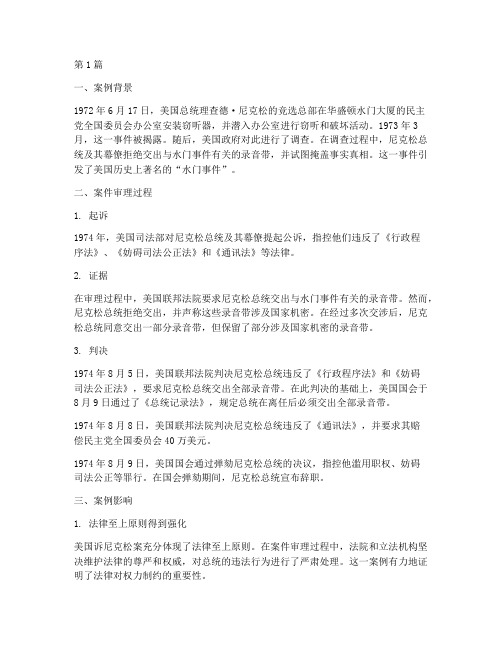
第1篇一、案例背景1972年6月17日,美国总统理查德·尼克松的竞选总部在华盛顿水门大厦的民主党全国委员会办公室安装窃听器,并潜入办公室进行窃听和破坏活动。
1973年3月,这一事件被揭露。
随后,美国政府对此进行了调查。
在调查过程中,尼克松总统及其幕僚拒绝交出与水门事件有关的录音带,并试图掩盖事实真相。
这一事件引发了美国历史上著名的“水门事件”。
二、案件审理过程1. 起诉1974年,美国司法部对尼克松总统及其幕僚提起公诉,指控他们违反了《行政程序法》、《妨碍司法公正法》和《通讯法》等法律。
2. 证据在审理过程中,美国联邦法院要求尼克松总统交出与水门事件有关的录音带。
然而,尼克松总统拒绝交出,并声称这些录音带涉及国家机密。
在经过多次交涉后,尼克松总统同意交出一部分录音带,但保留了部分涉及国家机密的录音带。
3. 判决1974年8月5日,美国联邦法院判决尼克松总统违反了《行政程序法》和《妨碍司法公正法》,要求尼克松总统交出全部录音带。
在此判决的基础上,美国国会于8月9日通过了《总统记录法》,规定总统在离任后必须交出全部录音带。
1974年8月8日,美国联邦法院判决尼克松总统违反了《通讯法》,并要求其赔偿民主党全国委员会40万美元。
1974年8月9日,美国国会通过弹劾尼克松总统的决议,指控他滥用职权、妨碍司法公正等罪行。
在国会弹劾期间,尼克松总统宣布辞职。
三、案例影响1. 法律至上原则得到强化美国诉尼克松案充分体现了法律至上原则。
在案件审理过程中,法院和立法机构坚决维护法律的尊严和权威,对总统的违法行为进行了严肃处理。
这一案例有力地证明了法律对权力制约的重要性。
2. 政治体制改革美国诉尼克松案促使美国政治体制改革。
在案件审理过程中,美国国会和司法机构对总统权力进行了重新审视,加强对总统权力的监督和制约。
此后,美国政治体制逐渐形成了权力制衡的机制。
3. 民主法治建设美国诉尼克松案对美国的民主法治建设产生了深远影响。
外国法律公平性案例分析(3篇)

第1篇案例背景:1954年,美国最高法院受理了一起名为美国诉布朗案的诉讼。
此案涉及了美国南卡罗来纳州斯图尔特维尔市的一所公立学校,该市在1951年根据种族隔离政策将公立学校划分为黑白两个学校系统。
黑人学生的家长认为这种种族隔离政策违反了美国宪法第十四条修正案中规定的平等保护原则,于是向法院提起诉讼。
案例简介:原告小路易斯·布朗和其他12名黑人学生家长代表,指控斯图尔特维尔市教育委员会和该市市长等被告,违反了美国宪法第十四条修正案。
原告要求法院判决废除这种种族隔离政策,并要求被告赔偿原告的损失。
法院判决:美国最高法院在1954年5月17日作出了判决,以9比0的多数票通过了判决书。
法院认为,种族隔离政策违反了美国宪法第十四条修正案中规定的平等保护原则。
法院指出,学校中的种族隔离政策本身就是不平等的,它给黑人学生造成了损害,剥夺了他们受教育的权利。
判决要点:1. 平等保护原则:法院认为,第十四条修正案的平等保护条款要求政府不得在种族问题上对不同群体施加不平等对待。
2. 种族隔离政策的不合理性:法院认为,种族隔离政策本身就构成了对黑人学生的不平等对待,因为它将黑人学生和白人学生分开,使得黑人学生无法享受到与白人学生相同的教育资源和机会。
3. 教育平等的重要性:法院强调,教育是提供平等机会的关键途径,种族隔离政策阻碍了黑人学生的教育平等。
案例分析:美国诉布朗案是美国历史上一个具有里程碑意义的案件,它对美国法律公平性产生了深远的影响。
以下是本案例的详细分析:1. 法律依据:法院在判决中明确指出,种族隔离政策违反了美国宪法第十四条修正案中的平等保护原则。
这一判决基于对宪法条款的准确解读和适用,体现了法律对公平正义的追求。
2. 社会影响:美国诉布朗案的判决在美国社会引起了广泛的关注和讨论。
该判决废除了学校中的种族隔离政策,为黑人争取了平等的教育机会,有助于消除种族歧视,促进种族和谐。
3. 法律发展:该判决对后来的法律发展产生了重要影响。
法律外国案例(3篇)

第1篇一、背景介绍美国“伯恩诉斯图尔特案”(Bourke v. Bullock)是20世纪90年代美国同性婚姻合法化运动中的一个标志性案件。
该案最终导致美国多个州承认同性婚姻,并引发了全国范围内关于同性婚姻合法性的激烈辩论。
以下是该案的详细背景和过程。
二、案情概述原告迈克尔·伯恩(Michael A. Bourke)和汤姆·斯图尔特(Tom C. Stewart)是一对同性伴侣,他们在1993年向阿拉巴马州法院申请结婚。
然而,根据阿拉巴马州法律,同性婚姻是非法的。
伯恩和斯图尔特随后向美国最高法院提起诉讼,挑战阿拉巴马州禁止同性婚姻的法律。
三、法院审理过程1. 地区法院审理案件首先在阿拉巴马州地区法院进行审理。
地区法院认为,同性婚姻侵犯了同性伴侣的基本权利,并判决阿拉巴马州禁止同性婚姻的法律违宪。
然而,阿拉巴马州州长唐·塞维尔(Don Siegelman)对此判决提出上诉。
2. 上诉法院审理案件随后上诉至美国第十一巡回上诉法院。
上诉法院维持了地区法院的判决,认为同性伴侣享有与异性伴侣相同的权利,禁止同性婚姻的法律违宪。
阿拉巴马州再次提出上诉。
3. 最高法院审理2003年,美国最高法院受理了该案。
最高法院在审理过程中,主要围绕以下几个方面展开辩论:(1)同性婚姻是否属于宪法第十四修正案所保护的“平等保护权”?(2)同性婚姻是否构成宪法第十四修正案所保护的“权利”?(3)同性婚姻是否违反了宪法第一条关于宗教自由的规定?四、判决结果2003年6月26日,美国最高法院以6比3的投票结果作出判决,支持地区法院和上诉法院的判决,认为同性婚姻合法。
以下是判决要点:1. 同性婚姻属于宪法第十四修正案所保护的“平等保护权”。
2. 同性伴侣享有与异性伴侣相同的权利,禁止同性婚姻的法律违宪。
3. 同性婚姻不违反宪法第一条关于宗教自由的规定。
五、案件影响美国“伯恩诉斯图尔特案”对美国同性婚姻合法化运动产生了深远的影响:1. 同性婚姻合法化进程加速:该案判决后,美国多个州开始承认同性婚姻。
2021_2022学年新教材高中政治第1单元各具特色的国家第2课第2框单一制和复合制学案部编版选择性

第二框单一制和复合制课标要求研学导航1.明确单一制国家的组成单位,理解单一制国家中央与地方的关系。
2.明确复合制国家的组成单位,理解复合制下整体与部分的关系。
3.了解邦联的特点。
4.把握国家结构形式的影响因素。
议题一| 什么是单一制1.国家的组成单位:按地域划分的普通行政区域或自治区域。
2.中央与地方的关系:在单一制国家中,中央享有最高权力;地方政权被置于中央政权的统一领导下,只能在宪法和法律规定的权限X围内行使职权。
1949年第一届中国人民政治协商会议筹备期间,就中华人民某某国的国家结构形式问题,征求过当时担任中央统战部部长的李维汉的意见。
李维汉对这个问题作过深入的研究。
他认为,中国同苏联国情不同,不宜实行联邦制。
理由是:一、苏联少数民族约占全国总人口的47%,与俄罗斯民族相差不远。
我国少数民族只占全国总人口的6%,并且呈现出大分散小聚居的状态,汉族和少数民族之间以及几个少数民族之间往往互相杂居或交错聚居。
二、苏联实行联邦制是由当时的形势决定的。
俄国经过二月革命和十月革命,许多民族实际上已经分离成为不同国家,不得不采取联邦制把按照苏维埃形式组成的各个国家联合起来,作为走向完全统一的过渡形式。
我国则是各民族在中国共产党领导下由平等联合进行革命,到平等联合建立统一的人民某某国,并没有经过民族分离。
因此,单一制的国家结构形式,更加符合中国的实际情况,在统一的国家内实行民族区域自治,更有利于民族平等原则的实现。
中央同意这个意见。
(1)(分析国家结构形式,坚持科学精神)我国为什么采取单一制的国家结构形式?(2)(分析单一制的作用,提升政治认同)实行单一制的国家结构形式,在统一的多民族国家中实行民族区域自治,具有哪些重要性和极其深远的意义?提示:(1)①现行宪法规定:“我国是各族人民共同缔造的统一的多民族国家。
”②历史原因:我国一直是统一的多民族的中央集权制国家。
尽管两千多年来几经分合,但国家的统一一直是主流。
案件概述联合公民诉联邦选举委员会案(CitizensUnitedvFederal
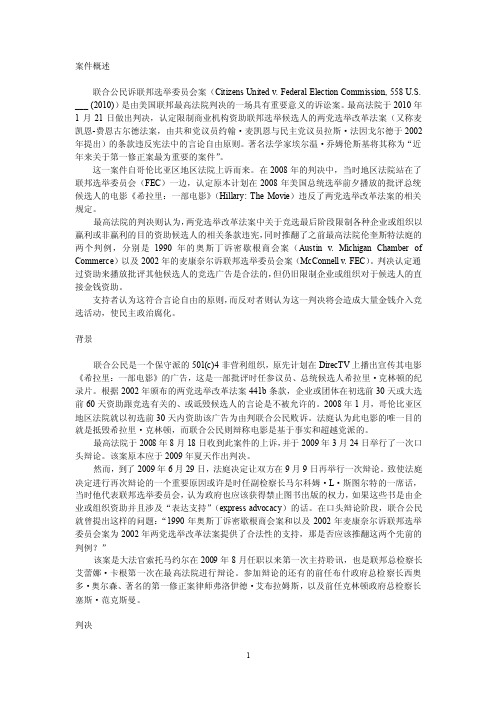
案件概述联合公民诉联邦选举委员会案(Citizens United v. Federal Election Commission, 558 U.S. ___ (2010))是由美国联邦最高法院判决的一场具有重要意义的诉讼案。
最高法院于2010年1月21日做出判决,认定限制商业机构资助联邦选举候选人的两党选举改革法案(又称麦凯恩-费恩古尔德法案,由共和党议员约翰·麦凯恩与民主党议员拉斯·法因戈尔德于2002年提出)的条款违反宪法中的言论自由原则。
著名法学家埃尔温·乔姆伦斯基将其称为“近年来关于第一修正案最为重要的案件”。
这一案件自哥伦比亚区地区法院上诉而来。
在2008年的判决中,当时地区法院站在了联邦选举委员会(FEC)一边,认定原本计划在2008年美国总统选举前夕播放的批评总统候选人的电影《希拉里:一部电影》(Hillary: The Movie)违反了两党选举改革法案的相关规定。
最高法院的判决则认为,两党选举改革法案中关于竞选最后阶段限制各种企业或组织以赢利或非赢利的目的资助候选人的相关条款违宪,同时推翻了之前最高法院伦奎斯特法庭的两个判例,分别是1990年的奥斯丁诉密歇根商会案(Austin v. Michigan Chamber of Commerce)以及2002年的麦康奈尔诉联邦选举委员会案(McConnell v. FEC)。
判决认定通过资助来播放批评其他候选人的竞选广告是合法的,但仍旧限制企业或组织对于候选人的直接金钱资助。
支持者认为这符合言论自由的原则,而反对者则认为这一判决将会造成大量金钱介入竞选活动,使民主政治腐化。
背景联合公民是一个保守派的501(c)4非营利组织,原先计划在DirecTV上播出宣传其电影《希拉里:一部电影》的广告,这是一部批评时任参议员、总统候选人希拉里·克林顿的纪录片。
根据2002年颁布的两党选举改革法案441b条款,企业或团体在初选前30天或大选前60天资助跟竞选有关的、或诋毁候选人的言论是不被允许的。
美国联邦法官裁定:猴子不拥有自拍照版权

美国联邦法官裁定:猴子不拥有自拍照版权
佚名
【期刊名称】《时代人物》
【年(卷),期】2016(000)002
【摘要】美国媒体/2016.1.12近日,美国一位联邦法官称,因自拍在网上走红的一只印尼猴子不拥有照片的版权。
善待动物组织在旧金山的美国地方法院为这只黑冠猕猴争取照片所有权。
照片是这只猴子用摄影师故意放在那里的相机自拍的。
1月6日,奥里克法官在一份初步意见书上写道:"虽然国会和总统可以把法律保护的范围扩展到不同人群甚至动物身上,但是在版权方面他们没有这样做过。
”
【总页数】1页(P46-46)
【正文语种】中文
【中图分类】D926.2
【相关文献】
1.与技术标准有关的专利许可声明对专利受让人约束力问题研究——从美国联邦贸易委员会N-Data案裁定出发 [J], 赵启杉
2.论技术标准中专利许可声明对专利受让人的约束力——从美国联邦贸易委员会N-Date案裁定出发 [J], 赵启杉
3.猴子真是了不起
——《了不起的猴子》导读 [J], 乐乐姐姐
4.美国联邦法院首次裁定医改法案条款违宪 [J],
5.美国法官判决猴子不拥有自拍照版权 [J],
因版权原因,仅展示原文概要,查看原文内容请购买。
世界法律史上经典案例(3篇)
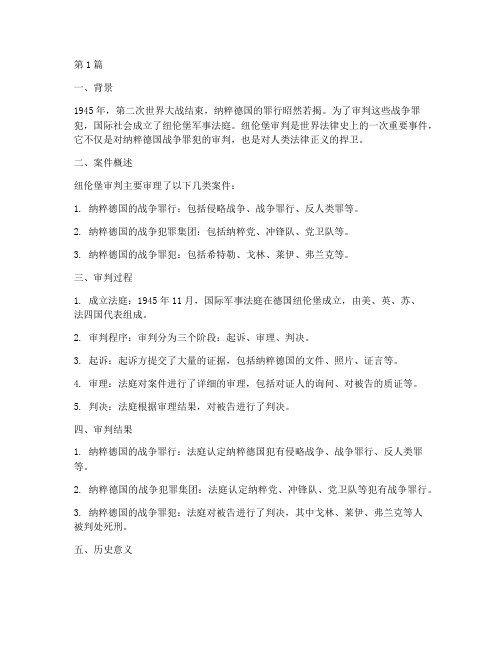
第1篇一、背景1945年,第二次世界大战结束,纳粹德国的罪行昭然若揭。
为了审判这些战争罪犯,国际社会成立了纽伦堡军事法庭。
纽伦堡审判是世界法律史上的一次重要事件,它不仅是对纳粹德国战争罪犯的审判,也是对人类法律正义的捍卫。
二、案件概述纽伦堡审判主要审理了以下几类案件:1. 纳粹德国的战争罪行:包括侵略战争、战争罪行、反人类罪等。
2. 纳粹德国的战争犯罪集团:包括纳粹党、冲锋队、党卫队等。
3. 纳粹德国的战争罪犯:包括希特勒、戈林、莱伊、弗兰克等。
三、审判过程1. 成立法庭:1945年11月,国际军事法庭在德国纽伦堡成立,由美、英、苏、法四国代表组成。
2. 审判程序:审判分为三个阶段:起诉、审理、判决。
3. 起诉:起诉方提交了大量的证据,包括纳粹德国的文件、照片、证言等。
4. 审理:法庭对案件进行了详细的审理,包括对证人的询问、对被告的质证等。
5. 判决:法庭根据审理结果,对被告进行了判决。
四、审判结果1. 纳粹德国的战争罪行:法庭认定纳粹德国犯有侵略战争、战争罪行、反人类罪等。
2. 纳粹德国的战争犯罪集团:法庭认定纳粹党、冲锋队、党卫队等犯有战争罪行。
3. 纳粹德国的战争罪犯:法庭对被告进行了判决,其中戈林、莱伊、弗兰克等人被判处死刑。
五、历史意义1. 纽伦堡审判为世界法律史树立了一个里程碑,它标志着人类对战争罪行的审判进入了一个新的阶段。
2. 纽伦堡审判确立了反人类罪、战争罪等国际罪行,为后来的国际刑事法庭提供了法律依据。
3. 纽伦堡审判对国际法的形成和发展产生了深远影响,推动了国际刑事司法的合作与交流。
4. 纽伦堡审判为世界和平与正义做出了重要贡献,为后世树立了法治的典范。
六、总结纽伦堡审判是世界法律史上的一次经典案例,它不仅是对纳粹德国战争罪犯的审判,更是对人类法律正义的捍卫。
纽伦堡审判的审判结果和意义,对后世产生了深远的影响,为世界和平与正义做出了重要贡献。
在当今世界,我们应铭记历史,珍惜和平,共同维护国际法的尊严和权威。
美国的审判制度
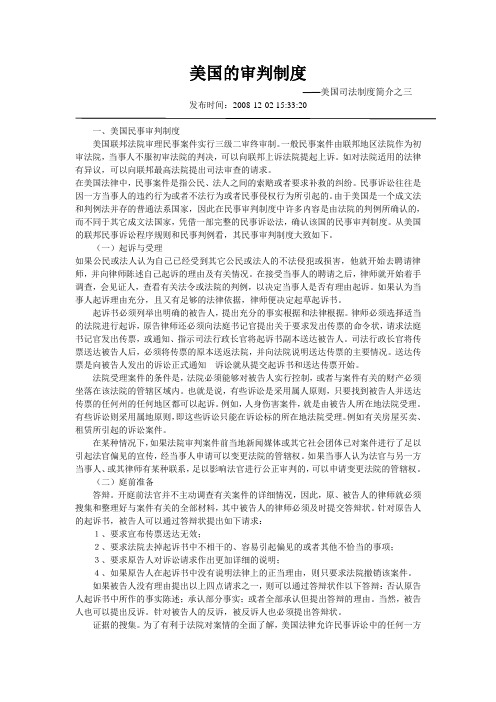
美国的审判制度——美国司法制度简介之三发布时间:2008-12-02 15:33:20一、美国民事审判制度美国联邦法院审理民事案件实行三级二审终审制。
一般民事案件由联邦地区法院作为初审法院,当事人不服初审法院的判决,可以向联邦上诉法院提起上诉。
如对法院适用的法律有异议,可以向联邦最高法院提出司法审查的请求。
在美国法律中,民事案件是指公民、法人之间的索赔或者要求补救的纠纷。
民事诉讼往往是因一方当事人的违约行为或者不法行为或者民事侵权行为所引起的。
由于美国是一个成文法和判例法并存的普通法系国家,因此在民事审判制度中许多内容是由法院的判例所确认的,而不同于其它成文法国家,凭借一部完整的民事诉讼法,确认该国的民事审判制度。
从美国的联邦民事诉讼程序规则和民事判例看,其民事审判制度大致如下。
(一)起诉与受理如果公民或法人认为自己已经受到其它公民或法人的不法侵犯或损害,他就开始去聘请律师,并向律师陈述自己起诉的理由及有关情况。
在接受当事人的聘请之后,律师就开始着手调查,会见证人,查看有关法令或法院的判例,以决定当事人是否有理由起诉。
如果认为当事人起诉理由充分,且又有足够的法律依据,律师便决定起草起诉书。
起诉书必须列举出明确的被告人,提出充分的事实根据和法律根据。
律师必须选择适当的法院进行起诉,原告律师还必须向法庭书记官提出关于要求发出传票的命令状,请求法庭书记官发出传票,或通知、指示司法行政长官将起诉书副本送达被告人。
司法行政长官将传票送达被告人后,必须将传票的原本送返法院,并向法院说明送达传票的主要情况。
送达传票是向被告人发出的诉讼正式通知诉讼就从提交起诉书和送达传票开始。
法院受理案件的条件是,法院必须能够对被告人实行控制,或者与案件有关的财产必须坐落在该法院的管辖区域内。
也就是说,有些诉讼是采用属人原则,只要找到被告人并送达传票的任何州的任何地区都可以起诉。
例如,人身伤害案件,就是由被告人所在地法院受理。
美国纽约州南区联邦地区法院判决(中英文本与注释)(一)

美国纽约州南区联邦地区法院判决(中英⽂本与注释)(⼀)从今天起将不定期发布美国联邦地区法院判决书的英⽂版及其翻译,欢迎指正。
UNITED STATES DISTRICT COURTSOUTHERN DISTRICT OF NEW YORK-------------------------------------------------------xUNITED STATES,v. No. 10CR228-LTSDANIEL BONVENTRE. et al.,-------------------------------------------------------x纽约州南区美国联邦地区法院[1]-------------------------------------------------------x美利坚合众国诉案号:10CR228-LTS丹尼尔•布恩⽂切等-------------------------------------------------------xOPINION AND ORDER[2]意见与判决APPEARANCES:出庭⼈员:UNITED STATES ATTORNEY’S OFFICE[3], LAW OFFICES OF ANDREWSOUTHERN DISTRICT OF NEW YORK J. FRISCH[4]纽约州南区 ANDREW J. FRISCH律师事务所美国联邦检察官办公室By: Matthew L. Schwartz, Esq.[5] By: Andrew J. Frisch, Esq.John T. Zach, Esq. Jeremy B. Sporn, Esq.Randall W. Jackson, Esq. Amanda Bassen, Esq.代表:Matthew L. Schwartz律师代表:Andrew J. Frisch律师John T. Zach律师 Jeremy B. Sporn律师Randall W. Jackson律师 Amanda Bassen律师One St. Andrew’s Plaza 40 Fulton Street, 23rd FloorNew York, NY 10007 New York, NY 10038Counsel for Daniel BonventreDaniel Bonventre的律师-and-与SERCARZ & RIOPELLE, LLP[6]By: Roland G. Riopelle, Esq.SERCARZ & RIOPELLE律师事务所代表:Roland G. Riopelle律师810 Seventh Avenue, Suite 620 New York, NY 10019Counsel for Annette BongiornoAnnette Bongiorno的律师-and-与DUANE MORRIS, LLP (NJ)By Eric R. Breslin, Esq.Melissa S. Geller, Esq.DUANE MORRIS律师事务所(新泽西州)代表:Eric R. Breslin律师Melissa S. Geller律师One Riverfront Plaza1037 Raymond Blvd., Suite 1800Newark, NJ 07102Counsel for Jo Ann CrupiJo Ann Crupi的律师LAW OFFICES OF GORDONMEHLER, PLLC[7]By: Gordon Mehler, Esq.Sarah Lum, Esq.GORDON MEHLER律师事务所代表:Gordon Mehler律师Sarah Lum律师747 Third Avenue, 32nd FloorNew York, NY 10019Counsel for Jerome O’HaraJerome O’Hara的律师-and-与KRANTZ AND BERMAN, LLPBy Larry H. Krantz, Esq.Kimberly A. Yuhas, Esq.KRANTZ AND BERMAN律师事务所代表:Larry H. Krantz律师Kimberly A. Yuhas律师747 Third Avenue, 32nd FloorNew York, NY 10017Counsel for George PerezGeorge Perez的律师LAURA TAYLOR SWAIN, UNITED STATES DISTRICT JUDGE美国联邦地区法官劳拉•泰勒•斯韦恩After a more than five month trial, thirty-one counts of the above-captioned[8] Superseding Indictment[9] were submitted to the jury, and Defendants Daniel Bonventre (“Bonventre”), Annette Bongiorno (“Bongiorno”), Jo Ann Crupi (“Crupi”), Jerome O’Hara (“O’Hara”) and George Perez (“Perez,” collectively, “Defendants”) were convicted of each of the crimes with which they were charged. The charges included: conspiracy to defraud investment advisory clients and conspiracy to commit securities fraud; conspiracy to engage in accounting fraud and to defraud banks; conspiracy to commit tax fraud; securities fraud; falsifying the records of a broker-dealer; falsifying the records of an investment adviser; causing a false and misleading filing to be made with the Securities and Exchange Commission (“SEC”); bank fraud; making and subscribing to false income tax returns; corruptly obstructing the lawful administration of the internal revenue laws; and tax evasion. Fewer than all of the Defendants were charged in some of the counts.经过五个多⽉的审理,在向陪审团提交上⽂⽂⾸所述替代起诉书的三⼗⼀项指控罪⾏后,被告丹尼尔•布恩⽂切(“布恩⽂切”)、安内特•布恩乔诺(“布恩乔诺”)、乔•安•克鲁⽪(“克鲁⽪”)、杰洛⽶•欧哈拉(“欧哈拉”)和乔治•佩雷兹(“佩雷兹”,上述⼈员合称“被告”)被判犯有各⾃被指控的每⼀项罪⾏。
外国传播法规经典案例

申克诉美国案(249 U.S. 47 (1919))是美国联邦最高法院判决的一宗支持1917年惩治间谍法的案例,最高法院在此案中指出被告无权援引美国宪法第一修正案包含的言论自由权利去批评美国政府在一战时期的征兵行为。
最后本案建立了明显和当前的危险标准,直到1927年其影响力才逐渐减弱,而对言论自由的限制最终在最高法院1969年作出的紧迫的不法行为标准中被放宽。
背景查尔斯·申克是时任美国社会党总书记,在一战期间负责向潜在的应征入伍者印刷、散发、邮寄传单,其中包括15000份反对征兵法的传单。
这些传单中写有“不要向恐吓屈服”,“坚持你的权利”,“如果你们不坚持和维护你们的权利,你们就是帮助否定或损害合众国全体公民和居民负有神圣义务加以保护的权利”等言论,申克等人这些传单上还指出是征兵可以看作是强制劳役,是为宪法第十三修正案所禁止的。
申克因此被指控并被判违反1917年惩治间谍法,申克遂上诉至联邦最高法院,认为地方法院的判决侵犯了美国宪法第一修正案所保护的公民言论自由的权利。
法院判决在由霍姆斯法官执笔的法院意见中,认为下级法院的有罪判决是符合宪法的。
第一修正案不保护鼓动推翻政府的言论,“当一个国家处于战争状态的时候,很多可能会在和平时期说出来的话会对国家的战争努力造成巨大妨害,以至于不能被容忍说出来,只要还有战士在战斗,就不会有一个法院会认为它们可以得到任何宪法保护。
”这也表明,法院认为,这些在战时受限制的言论,将会在和平时期被允许。
霍姆斯在这份法院意见中,提出了他著名的明显和当前的危险标准。
言论自由最严格的保护也不会保护一个人在戏院中虚假地大喊失火而引起恐慌[...]在每一个案件中,问题在于言论是否被用于这样一种环境,属于这样一种性质,以至于造成了国会有权制止的巨大祸害的明显和当前的危险。
这份法院意见中“戏院火警”的比喻也出现在了之后的许多判决上。
申克最终被判监禁六个月。
后续的法律理论“明显和当前的危险”标准最后被更加严厉的“坏倾向”标准在惠特尼诉加利福尼亚州案中取代,霍姆斯法官和路易斯·布兰戴斯法官没有明确赞同新标准,但支持了对惠特尼的有罪判决。
评述美国联邦上诉法院就对华产品“特保”第一案的判决
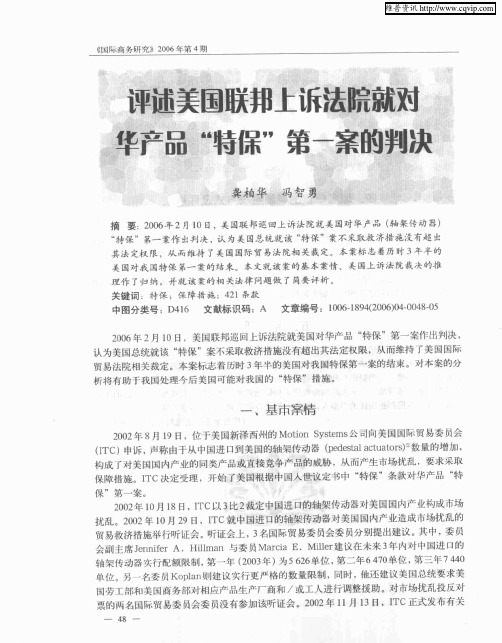
中图分类号 : 4 6 文献标识码 :A 文章编号 :l 6 I9 (0 6 404 —5 D 1 0 一842 o ) ・ 80 0 0 0 20 年 2 1 06 月 0日,美国联邦巡回上诉法院 就美国对华 产品 “ 特保”第一案作出判决, 认 为美国总统就该 “ 特保 ”案不采取救济措施没有超出其法定权限,从而维持 了美 国国际 贸易法院相关裁定。本案标志着历时 3 年半的美国对我国特保第一案的结 束。对本案的分 析将有助于我国处理今后美国可能对我国的 。 保”措 施。 特
其 法 定 权 限 ,从 而 维特 T美 国 国 际 贸 易 法 院 相 关 裁 定 。 拳案 标 志 着历 时 3年 半 的
美国对我 国特保 第一案的结束。本文税该案的基本案情、美国上诉 法院簌决 的推 理作 7归 纳,并就该案的相关法律问题做 7简要评析 。 关键词 :特保 保障措施 ; 2 条款 41
超越制 造 商的受 益 。
2 0 年 4月 9日,Moin S se 03 t y tms 公司在 美 国 国际贸 易法院 起诉 美 国总统 和美 国 贸 o 易代表 ,对 美 国总统拒 绝采 取 贸易救 济措 施的决 定提 出司法 审查 。原 告认 为 ,总 统 的决定
超越 了第 4 1 2 条规 定 的授权 范 围 , 总统混 淆 了第 4 1 2 条规定 的 在特定 的情 况下 总统 可以 拒绝
20 0 4年 6月 3日,美 国国际 贸 易法院 作 出判 决 ,维 持 美 国总统 的决 定 。然 而 ,Moin t o
S se y tm公司不服 美 国 国际贸 易法院 的判决 , 即上 诉到 美 国联 邦巡 回上 诉法 院 , 求重 审 。 随 要
20 年 2月 1 06 0日,美 国联 邦 巡 回上 诉法 院就 美 国对华 座椅升 降装 置 “ 保 ”案的 司法 特
美国联邦法院判决

1 (Slip Opinion) OCTOBER TERM, 2010SyllabusNOTE: Where it is feasible, a syllabus (headnote) will be released, as isbeing done in connection with this case, at the time the opinion is issued.The syllabus constitutes no part of the opinion of the Court but has beenprepared by the Reporter of Decisions for the convenience of the reader.See United States v. Detroit Timber & Lumber Co., 200 U. S. 321, 337. SUPREME COURT OF THE UNITED STATESSyllabusTHOMPSON v. NORTH AMERICAN STAINLESS, LPCERTIORARI TO THE UNITED STATES COURT OF APPEALS FORTHE SIXTH CIRCUITNo. 09–291. Argued December 7, 2010—Decided January 24, 2011 After petitioner Thompson’s fiancée, Miriam Regalado, filed a sex discrimination charge with the Equal Employment Opportunity Commission (EEOC) against their employer, respondent North American Stainless (NAS), NAS fired Thompson. He filed his own charge and a subsequent suit under Title VII of the Civil Rights Act, claiming that NAS fired him to retaliate against Regalado for filing her charge. The District Court granted NAS summary judgment on the ground that third-party retaliation claims were not permitted by Title VII, which prohibits discrimination against an employee “because he has made a [Title VII] charge,” 42 U. S. C. §2000e–3(a), and which permits, inter alia, a “person claiming to be aggrieved . . . by [an] alleged employment practice” to file a civil action, §2000e–5(f)(1). The en banc Sixth Circuit affirmed, reasoning that Thompson was not entitled to sue NAS for retaliation because he had not engaged in any activity protected by the statute.Held:1. If the facts Thompson alleges are true, his firing by NAS constituted unlawful retaliation. Title VII’s antiretaliation provision must be construed to cover a broad range of employer conduct. Burlington N. & S. F. R. Co. v. White, 548 U. S. 53. It prohibits any employer action that “ ‘well might have “dissuaded a reasonable worker from making or supporting a [discrimination] charge,” ’” id., at 68. That test must be applied in an objective fashion, to “avoi[d] the uncertainties and unfair discrepancies that can plague a judicial effort to determine a plaintiff’s unusual subjective feelings.” Id., at 68–69. A reasonable worker obviously might be dissuaded from engaging in protected activity if she knew that her fiancé would be fired. Pp. 2–4.2. Title VII grants Thompson a cause of action. Pp. 4–7.2 THOMPSONv. NORTH AMERICAN STAINLESS, LPSyllabus(a) For Title VII standing purposes, the term “person aggrieved” must be construed more narrowly than the outer boundaries of Article III. Dictum in Trafficante v. Metropolitan Life Ins. Co., 409 U. S. 205, suggesting that Title VII’s aggrievement requirement reaches as far as Article III permits, is too expansive and the Court declines to follow it. At the other extreme, limiting “person aggrieved” to the person who was the subject of unlawful retaliation is an artificially narrow reading. A common usage of the term “person aggrieved” avoids both of these extremes. The Administrative Procedure Act, which authorizes suit to challenge a federal agency by any “person . . . adversely affected or aggrieved . . . within the meaning of a relevant statute,” 5 U. S. C. §702, establishes a regime under which a plaintiff may not sue unless he “falls within the ‘zone of interests’sought to be protected by the statutory provision whose violation forms the legal basis for his complaint,” Lujan v. National Wildlife Federation, 497 U. S. 871, 883. Title VII’s term “aggrieved” incorporates that test, enabling suit by any plaintiff with an interest “ ‘arguably [sought] to be protected’ by the statutes,” National Credit Un-ion Admin. v. First Nat. Bank & Trust Co., 522 U. S. 479, 495, while excluding plaintiffs who might technically be injured in an Article III sense but whose interests are unrelated to Title VII’s statutory prohibitions. Pp. 4–7.(b) Applying that test here, Thompson falls within the zone of interests protected by Title VII. He was an employee of NAS, and Title VII’s purpose is to protect employees from their employers’ unlawful actions. Moreover, accepting the facts as alleged, Thompson is not an accidental victim of the retaliation. Hurting him was the unlawful act by which NAS punished Regalado. Thus, Thompson is a person aggrieved with standing to sue under Title VII. P. 7.567 F. 3d 804, reversed and remanded.S CALIA, J., delivered the opinion of the Court, in which all other Members joined, except K AGAN, J., who took no part in the consideration or decision of the case. G INSBURG, J., filed a concurring opinion, in which B REYER, J., joined.__________________________________Cite as: 562 U. S. ____ (2011)1Opinion of the CourtNOTICE: This opinion is subject to formal revision before publication in the preliminary print of the United States Reports. Readers are requested to notify the Reporter of Decisions, Supreme Court of the United States, Washington, D. C. 20543, of any typographical or other formal errors, in order that corrections may be made before the preliminary print goes to press. SUPREME COURT OF THE UNITED STATESNo. 09–291ERIC L. THOMPSON, PETITIONER v. NORTHAMERICAN STAINLESS, LPON WRIT OF CERTIORARI TO THE UNITED STATES COURT OFAPPEALS FOR THE SIXTH CIRCUIT[January 24, 2011]J USTICE S CALIA delivered the opinion of the Court.Until 2003, both petitioner Eric Thompson and his fiancée, Miriam Regalado, were employees of respondent North American Stainless (NAS). In February 2003, the Equal Employment Opportunity Commission (EEOC)notified NAS that Regalado had filed a charge alleging sex discrimination. Three weeks later, NAS fired Thompson. Thompson then filed a charge with the EEOC. After conciliation efforts proved unsuccessful, he sued NAS in the United States District Court for the Eastern District of Kentucky under Title VII of the Civil Rights Act of 1964,78 Stat. 253, 42 U. S. C. §2000e et seq ., claiming that NAS had fired him in order to retaliate against Regalado for filing her charge with the EEOC. The District Court granted summary judgment to NAS, concluding that Title VII “does not permit third party retaliation claims.” 435 F. Supp. 2d 633, 639 (ED Ky. 2006). After a panel of the Sixth Circuit reversed the District Court, the Sixth Circuit granted rehearing en banc and affirmed by a 10-to-6 vote.567 F. 3d 804 (2009). The court reasoned that because Thompson did not “engag[e] in any statutorily protected2 THOMPSONv. NORTH AMERICAN STAINLESS, LPOpinion of the Courtactivity, either on his own behalf or on behalf of Miriam Regalado,” he “is not included in the class of persons for whom Congress created a retaliation cause of action.” Id., at 807–808.We granted certiorari. 561 U. S. ___ (2010).ITitle VII provides that “[i]t shall be an unlawful employment practice for an employer to discriminate against any of his employees . . . because he has made a charge” under Title VII. 42 U. S. C. §2000e–3(a). The statute permits “a person claiming to be aggrieved” to file a charge with the EEOC alleging that the employer committed an unlawful employment practice, and, if the EEOC declines to sue the employer, it permits a civil action to “be brought . . . by the person claiming to be aggrieved . . . by the alleged unlawful employment practice.” §2000e–5(b), (f)(1).It is undisputed that Regalado’s filing of a charge with the EEOC was protected conduct under Title VII. In the procedural posture of this case, we are also required to assume that NAS fired Thompson in order to retaliate against Regalado for filing a charge of discrimination. This case therefore presents two questions: First, did NAS’s firing of Thompson constitute unlawful retaliation? And second, if it did, does Title VII grant Thompson a cause of action?IIWith regard to the first question, we have little difficulty concluding that if the facts alleged by Thompson are true, then NAS’s firing of Thompson violated Title VII. In Burlington N. & S. F. R. Co. v. White, 548 U. S. 53 (2006), we held that Title VII’s antiretaliation provision must be construed to cover a broad range of employer conduct. We reached that conclusion by contrasting the text of Title3Cite as: 562 U. S. ____ (2011)Opinion of the CourtVII’s antiretaliation provision with its substantive antidiscrimination provision. Title VII prohibits discrimination on the basis of race, color, religion, sex, and national origin “‘with respect to . . . compensation, terms, conditions, or privileges of employment,’” and discriminatory practices that would “‘deprive any individual of employment opportunities or otherwise adversely affect his status as an employee.’” Id., at 62 (quoting 42 U. S. C. §2000e–2(a) (emphasis deleted)). In contrast, Title VII’s antiretaliation provision prohibits an employer from “‘discriminat[ing] against any of his employees’” for engaging in protected conduct, without specifying the employer acts that are prohibited. 548 U. S., at 62 (quoting §2000e–3(a) (emphasis deleted)). Based on this textual distinction and our understanding of the antiretaliation provision’s purpose, we held that “the antiretaliation provision, unlike the substantive provision, is not limited to discriminatory actions that affect the terms and conditions of employment.” Id., at 64. Rather, Title VII’s antiretaliation provision prohibits any employer action that “well might have dissuaded a reasonable worker from making or supporting a charge of discrimination.” Id., at 68 (internal quotation marks omitted).We think it obvious that a reasonable worker might be dissuaded from engaging in protected activity if she knew that her fiancé would be fired. Indeed, NAS does not dispute that Thompson’s firing meets the standard set forth in Burlington. Tr. of Oral Arg. 30. NAS raises the concern, however, that prohibiting reprisals against third parties will lead to difficult line-drawing problems concerning the types of relationships entitled to protection. Perhaps retaliating against an employee by firing his fiancée would dissuade the employee from engaging in protected activity, but what about firing an employee’s girlfriend, close friend, or trusted co-worker? Applying the Burlington standard to third-party reprisals, NAS argues,4 THOMPSONv. NORTH AMERICAN STAINLESS, LPOpinion of the Courtwill place the employer at risk any time it fires any employee who happens to have a connection to a different employee who filed a charge with the EEOC.Although we acknowledge the force of this point, we do not think it justifies a categorical rule that third-party reprisals do not violate Title VII. As explained above, we adopted a broad standard in Burlington because Title VII’s antiretaliation provision is worded broadly. We think there is no textual basis for making an exception to it for third-party reprisals, and a preference for clear rules cannot justify departing from statutory text.We must also decline to identify a fixed class of relationships for which third-party reprisals are unlawful. We expect that firing a close family member will almost always meet the Burlington standard, and inflicting a milder reprisal on a mere acquaintance will almost never do so, but beyond that we are reluctant to generalize. As we explained in Burlington, 548 U. S., at 69, “the significance of any given act of retaliation will often depend upon the particular circumstances.” Given the broad statutory text and the variety of workplace contexts in which retaliation may occur, Title VII’s antiretaliation provision is simply not reducible to a comprehensive set of clear rules. We emphasize, however, that “the provision’s standard for judging harm must be objective,” so as to “avoi[d] the uncertainties and unfair discrepancies that can plague a judicial effort to determine a plaintiff’s unusual subjective feelings.” Id., at 68–69.IIIThe more difficult question in this case is whether Thompson may sue NAS for its alleged violation of Title VII. The statute provides that “a civil action may be brought . . . by the person claiming to be aggrieved.” 42 U. S. C. §2000e–5(f)(1). The Sixth Circuit concluded that this provision was merely a reiteration of the requirement5Cite as: 562 U. S. ____ (2011)Opinion of the Courtthat the plaintiff have Article III standing. 567 F. 3d, at 808, n. 1. We do not understand how that can be. The provision unquestionably permits a person “claiming to be aggrieved” to bring “a civil action.” It is arguable that the aggrievement referred to is nothing more than the minimal Article III standing, which consists of injury in fact caused by the defendant and remediable by the court. See Lujan v. Defenders of Wildlife, 504 U. S. 555, 560–561 (1992). But Thompson’s claim undoubtedly meets those requirements, so if that is indeed all that aggrievement consists of, he may sue.We have suggested in dictum that the Title VII aggrievement requirement conferred a right to sue on all who satisfied Article III standing. Trafficante v. Metro-politan Life Ins. Co., 409 U. S. 205 (1972), involved the “person aggrieved” provision of Title VIII (the Fair Housing Act) rather than Title VII. In deciding the case, however, we relied upon, and cited with approval, a Third Circuit opinion involving Title VII, which, we said, “concluded that the words used showed ‘a congressional intention to define standing as broadly as is permitted by Article III of the Constitution.’ ” Id., at 209 (quoting Hackett v. McGuire Bros., Inc., 445 F. 2d 442, 446 (1971)). We think that dictum regarding Title VII was too expansive. Indeed, the Trafficante opinion did not adhere to it in expressing its Title VIII holding that residents of an apartment complex could sue the owner for his racial discrimination against prospective tenants. The opinion said that the “person aggrieved” of Title VIII was coextensive with Article III “insofar as tenants of the same hous-ing unit that is charged with discrimination are con-cerned.” 409 U. S., at 209 (emphasis added). Later opinions, we must acknowledge, reiterate that the term “aggrieved” in Title VIII reaches as far as Article III permits, see Bennett v. Spear, 520 U. S. 154, 165–166 (1997); Gladstone, Realtors v. Village of Bellwood, 441 U. S. 91,6 THOMPSONv. NORTH AMERICAN STAINLESS, LPOpinion of the Court109 (1979), though the holdings of those cases are compatible with the “zone of interests” limitation that we discuss below. In any event, it is Title VII rather than Title VIII that is before us here, and as to that we are surely not bound by the Trafficante dictum.We now find that this dictum was ill-considered, and we decline to follow it. If any person injured in the Article III sense by a Title VII violation could sue, absurd consequences would follow. For example, a shareholder would be able to sue a company for firing a valuable employee for racially discriminatory reasons, so long as he could show that the value of his stock decreased as a consequence. At oral argument Thompson acknowledged that such a suit would not lie, Tr. of Oral Arg. 5–6. We agree, and therefore conclude that the term “aggrieved” must be construed more narrowly than the outer boundaries of Article III.At the other extreme from the position that “person aggrieved” means anyone with Article III standing, NAS argues that it is a term of art that refers only to the employee who engaged in the protected activity. We know of no other context in which the words carry this artificially narrow meaning, and if that is what Congress intended it would more naturally have said “person claiming to have been discriminated against” rather than “person claiming to be aggrieved.” We see no basis in text or prior practice for limiting the latter phrase to the person who was the subject of unlawful retaliation. Moreover, such a reading contradicts the very holding of Trafficante, which was that residents of an apartment complex were “person[s] aggrieved” by discrimination against prospective tenants. We see no reason why the same phrase in Title VII should be given a narrower meaning.In our view there is a common usage of the term “person aggrieved” that avoids the extremity of equating it with Article III and yet is fully consistent with our application of the term in Trafficante. The Administrative Procedure7Cite as: 562 U. S. ____ (2011)Opinion of the CourtAct, 5 U. S. C. §551 et seq., authorizes suit to challenge a federal agency by any “person . . . adversely affected or aggrieved . . . within the meaning of a relevant statute.” §702. We have held that this language establishes a regime under which a plaintiff may not sue unless he “falls within the ‘zone of interests’ sought to be protected by the statutory provision whose violation forms the legal basis for his complaint.” Lujan v. National Wildlife Fed-eration, 497 U. S. 871, 883 (1990). We have described the “zone of interests” test as denying a right of review “if the plaintiff’s interests are so marginally related to or inconsistent with the purposes implicit in the statute that it cannot reasonably be assumed that Congress intended to permit the suit.” Clarke v. Securities Industry Assn., 479 U. S. 388, 399–400 (1987). We hold that the term “aggrieved” in Title VII incorporates this test, enabling suit by any plaintiff with an interest “arguably [sought] to be protected by the statutes,” National Credit Union Admin. v. First Nat. Bank & Trust Co., 522 U. S. 479, 495 (1998) (internal quotation marks omitted), while excluding plaintiffs who might technically be injured in an Article III sense but whose interests are unrelated to the statutory prohibitions in Title VII.Applying that test here, we conclude that Thompson falls within the zone of interests protected by Title VII. Thompson was an employee of NAS, and the purpose of Title VII is to protect employees from their employers’unlawful actions. Moreover, accepting the facts as alleged, Thompson is not an accidental victim of the retaliation—collateral damage, so to speak, of the employer’s unlawful act. To the contrary, injuring him was the employer’s intended means of harming Regalado. Hurting him was the unlawful act by which the employer punished her. In those circumstances, we think Thompson well within the zone of interests sought to be protected by Title VII. He is a person aggrieved with standing to sue.8 THOMPSONv. NORTH AMERICAN STAINLESS, LPOpinion of the Court* * *The judgment of the Sixth Circuit is reversed, and the case is remanded for further proceedings consistent with this opinion.It is so ordered. J USTICE K AGAN took no part in the consideration or decision of this case._________________ _________________ 1Cite as: 562 U. S. ____ (2011)G INSBURG, J., concurringSUPREME COURT OF THE UNITED STATESNo. 09–291ERIC L. THOMPSON, PETITIONER v. NORTHAMERICAN STAINLESS, LPON WRIT OF CERTIORARI TO THE UNITED STATES COURT OFAPPEALS FOR THE SIXTH CIRCUIT[January 24, 2011]J USTICE G INSBURG, with whom J USTICE B REYER joins, concurring.I join the Court’s opinion, and add a fortifying observa-tion: Today’s decision accords with the longstanding views of the Equal Employment Opportunity Commission (EEOC), the federal agency that administers Title VII. In its Compliance Manual, the EEOC counsels that Title VII “prohibit[s] retaliation against someone so closely related to or associated with the person exercising his or her statutory rights that it would discourage or prevent the person from pursuing those rights.” Brief for United States as Amicus Curiae 12–13 (quoting EEOC Compli-ance Manual §8–II(C)(3) (1998)). Such retaliation “can be challenged,” the Manual affirms, “by both the individual who engaged in protected activity and the relative, where both are employees.” Id., at 25–26 (quoting Compliance Manual §8–II(B)(3)(c)). The EEOC’s statements in the Manual merit deference under Skidmore v. Swift & Co., 323 U. S. 134 (1944). See Federal Express Corp. v. Holowecki, 552 U. S. 389, 399–400 (2008). The EEOC’s interpretation of Title VII, I further note, is consistent with interpretations of analogous statutes by other federal agencies. See, e.g., NLRB v. Advertisers Mfg. Co., 823 F. 2d 1086, 1088–1089 (CA7 1987) (adopting NLRB’s position that retaliation against a relative violates the Nationalv. NORTH AMERICAN STAINLESS, LP2 THOMPSONG INSBURG, J., concurringLabor Relations Act); Tasty Baking Co. v. NLRB, 254 F. 3d 114, 127–128 (CADC 2001) (same), cited in Brief for United States as Amicus Curiae 11.。
宪法案例三 撤销的规范性文件或宣布选举无效
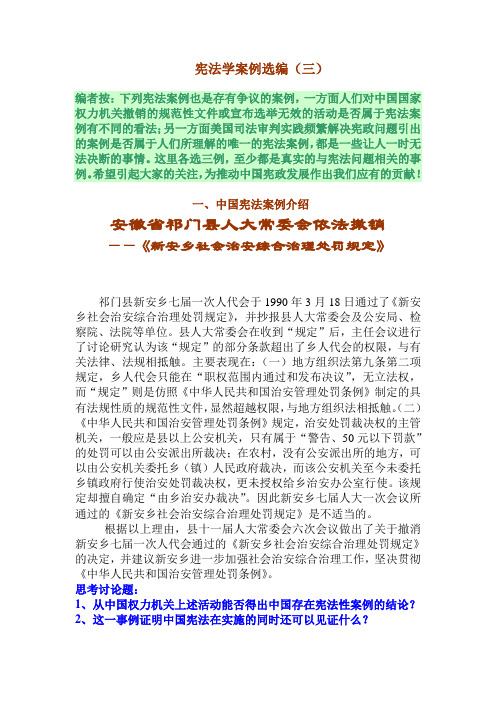
宪法学案例选编(三)编者按:下列宪法案例也是存有争议的案例,一方面人们对中国国家权力机关撤销的规范性文件或宣布选举无效的活动是否属于宪法案例有不同的看法;另一方面美国司法审判实践频繁解决宪政问题引出的案例是否属于人们所理解的唯一的宪法案例,都是一些让人一时无法决断的事情。
这里各选三例,至少都是真实的与宪法问题相关的事例。
希望引起大家的关注,为推动中国宪政发展作出我们应有的贡献!一、中国宪法案例介绍安徽省祁门县人大常委会依法撤销——《新安乡社会治安综合治理处罚规定》祁门县新安乡七届一次人代会于1990年3月18日通过了《新安乡社会治安综合治理处罚规定》,并抄报县人大常委会及公安局、检察院、法院等单位。
县人大常委会在收到“规定”后,主任会议进行了讨论研究认为该“规定”的部分条款超出了乡人代会的权限,与有关法律、法规相抵触。
主要表现在:(一)地方组织法第九条第二项规定,乡人代会只能在“职权范围内通过和发布决议”,无立法权,而“规定”则是仿照《中华人民共和国治安管理处罚条例》制定的具有法规性质的规范性文件,显然超越权限,与地方组织法相抵触。
(二)《中华人民共和国治安管理处罚条例》规定,治安处罚裁决权的主管机关,一般应是县以上公安机关,只有属于“警告、50元以下罚款”的处罚可以由公安派出所裁决;在农村,没有公安派出所的地方,可以由公安机关委托乡(镇)人民政府裁决,而该公安机关至今未委托乡镇政府行使治安处罚裁决权,更未授权给乡治安办公室行使。
该规定却擅自确定“由乡治安办裁决”。
因此新安乡七届人大一次会议所通过的《新安乡社会治安综合治理处罚规定》是不适当的。
根据以上理由,县十一届人大常委会六次会议做出了关于撤消新安乡七届一次人代会通过的《新安乡社会治安综合治理处罚规定》的决定,并建议新安乡进一步加强社会治安综合治理工作,坚决贯彻《中华人民共和国治安管理处罚条例》。
思考讨论题:1、从中国权力机关上述活动能否得出中国存在宪法性案例的结论?2、这一事例证明中国宪法在实施的同时还可以见证什么?3、国家权力机关的宪政地位是什么?湖北省洪湖市人大常委会依法宣布螺山镇镇长、副镇长的选举无效1990年3月底四月初,洪湖市人大常委会、湖北省人大常委会办公厅先后收到洪湖市螺山镇人大代表的来信,反映该镇人代会在补选政府领导人时有违法问题。
美国联邦法院的层级与管辖
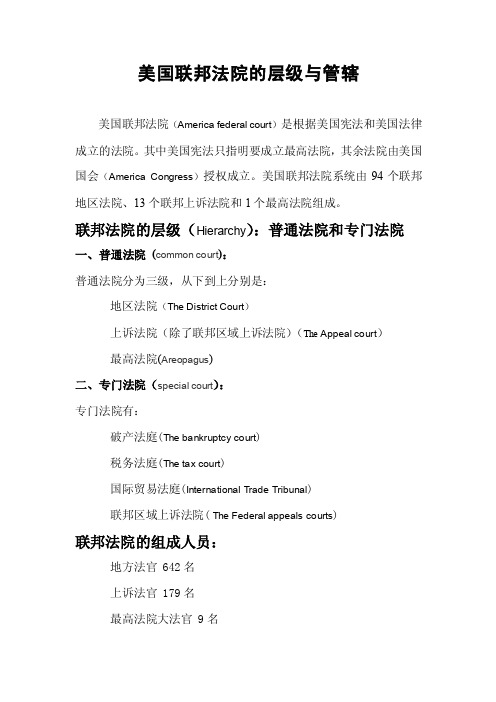
美国联邦法院的层级与管辖美国联邦法院(America federal court)是根据美国宪法和美国法律成立的法院。
其中美国宪法只指明要成立最高法院,其余法院由美国国会(America Congress)授权成立。
美国联邦法院系统由94个联邦地区法院、13个联邦上诉法院和1个最高法院组成。
联邦法院的层级(Hierarchy):普通法院和专门法院一、普通法院(common court):普通法院分为三级,从下到上分别是:地区法院(The District Court)上诉法院(除了联邦区域上诉法院)(The Appeal court)最高法院(Areopagus)二、专门法院(special court):专门法院有:破产法庭(The bankruptcy court)税务法庭(The tax court)国际贸易法庭(International Trade Tribunal)联邦区域上诉法院(The Federal appeals courts)联邦法院的组成人员:地方法官 642名上诉法官 179名最高法院大法官 9名共840名联邦法官,均为终身制(Lifelong system)。
联邦法院的管辖(Jurisdiction):一、地区法院地区法院是初审(The trial)管辖法院,只有联邦的司法管辖权(right of jurisdiction)。
经联邦地方法院判决的案件,大多数可以上诉到联邦上诉法院,有少数几种可以直接上诉到最高法院。
二、上诉法院上诉法院只有上诉管辖权,受理经辖区内联邦地区法院判决的案件的上诉,也审查联邦贸易委员会(The Federal Trade Commission)之类的独立管理机构的行动。
三、最高法院联邦法院是最后上诉法院。
美国联邦最高法院的管辖权分初审管辖权和上诉管辖权。
其初审管辖权只适用于两类案件:一是涉及大使(Ambassador)、其他公使(minister)和领事(Consul)的案件,另一类是一州为一方当事人的一切案件。
英美法律案例及分析(3篇)
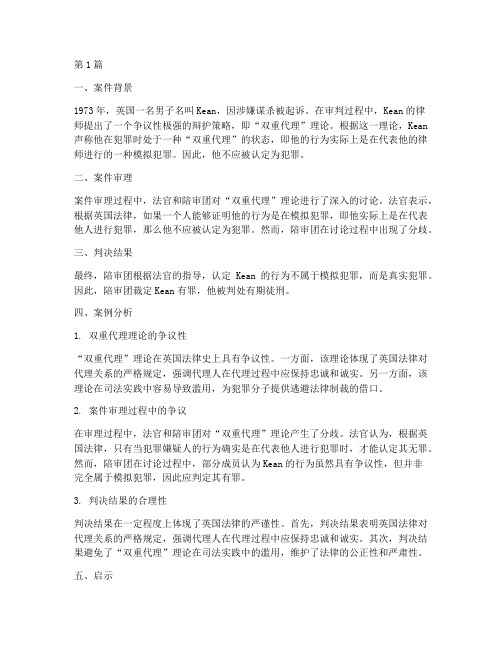
第1篇一、案件背景1973年,英国一名男子名叫Kean,因涉嫌谋杀被起诉。
在审判过程中,Kean的律师提出了一个争议性极强的辩护策略,即“双重代理”理论。
根据这一理论,Kean 声称他在犯罪时处于一种“双重代理”的状态,即他的行为实际上是在代表他的律师进行的一种模拟犯罪。
因此,他不应被认定为犯罪。
二、案件审理案件审理过程中,法官和陪审团对“双重代理”理论进行了深入的讨论。
法官表示,根据英国法律,如果一个人能够证明他的行为是在模拟犯罪,即他实际上是在代表他人进行犯罪,那么他不应被认定为犯罪。
然而,陪审团在讨论过程中出现了分歧。
三、判决结果最终,陪审团根据法官的指导,认定Kean的行为不属于模拟犯罪,而是真实犯罪。
因此,陪审团裁定Kean有罪,他被判处有期徒刑。
四、案例分析1. 双重代理理论的争议性“双重代理”理论在英国法律史上具有争议性。
一方面,该理论体现了英国法律对代理关系的严格规定,强调代理人在代理过程中应保持忠诚和诚实。
另一方面,该理论在司法实践中容易导致滥用,为犯罪分子提供逃避法律制裁的借口。
2. 案件审理过程中的争议在审理过程中,法官和陪审团对“双重代理”理论产生了分歧。
法官认为,根据英国法律,只有当犯罪嫌疑人的行为确实是在代表他人进行犯罪时,才能认定其无罪。
然而,陪审团在讨论过程中,部分成员认为Kean的行为虽然具有争议性,但并非完全属于模拟犯罪,因此应判定其有罪。
3. 判决结果的合理性判决结果在一定程度上体现了英国法律的严谨性。
首先,判决结果表明英国法律对代理关系的严格规定,强调代理人在代理过程中应保持忠诚和诚实。
其次,判决结果避免了“双重代理”理论在司法实践中的滥用,维护了法律的公正性和严肃性。
五、启示1. 法律的严谨性该案例表明,英国法律在审理案件时,注重法律的严谨性和公正性。
在审理过程中,法官和陪审团对争议性极强的理论进行了深入的讨论,最终做出了合理的判决。
2. 代理关系的规范该案例提醒我们,代理关系在法律实践中具有重要意义。
美国联邦最高法院司法审查第一案
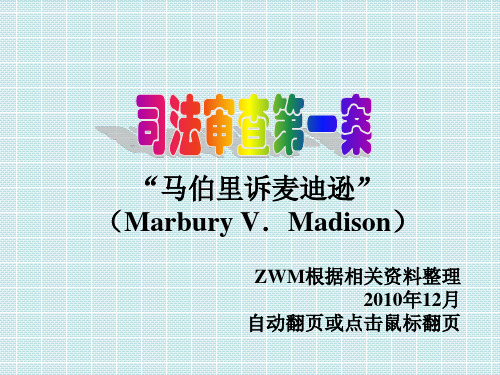
马伯里诉麦迪逊”(Marbury V.Madison)ZWM根据相关资料整理2010年12月自动翻页或点击鼠标翻页1776年7月4日由托玛斯·杰弗逊起草,其它13个殖民地代表在费城签署《独立宣言》,声明美国从英国独立。
《独立宣言》是具有世界历史意义的伟大文献。
美国1781年颁布《邦联章程》(Articles of Confederation) ,名称定为“美利坚合众国”•将税收权及贸易监管权在内的大部分权力留给了13个州。
这些州的职能几乎相当于独立的国家,它们之间甚至展开了贸易战。
拟定《邦联条例》(Articles of Confederation)在美国独立战争于1783年结束时,国家政府没有总统,只有一个实行一院制的国会,协助解决安全等受到普遍关注的问题。
事实证明这个体制无效力可言,因为国会既不能征税,也不能实施法律。
1786年9月11日,一个讨论跨州贸易的会议在马里兰州安纳波利斯(Annapolis)举行。
会议建议于1787年在费城举行一个由各州代表参加的大型会议,"以拟订他们认为可使联邦政府的宪法足以应对联邦急务所必需的新条款"。
1787年1月爆发的"沙依起义"(Shay's Rebellion)突显了局势的严重性。
2000名参加过美国独立战争的老兵武装起来,占领了马萨诸塞州的一个武器库。
高额税收以及因负债累累而失去农田使得他们揭竿而起。
•这次起义暴露了中央政府的软弱无能以及常备军队的不足,引起了很多美国领导人的警觉,其中包括在独立战争中做过美军统帅的乔治·华盛顿(George Washington)。
他写道:"除非迅速采取补救措施,否则无政府及混乱状态必将接踵而至。
"1787年5月25日,代表们云集费城,提名华盛顿为制宪会议主席。
作为一名举国爱戴的英雄人物,华盛顿的出席为大会增添了合法性。
这在当时是一个重要考虑,因为代表们决定不公开进行讨论,以便他们在制定取代《邦联章程》的文件时能够畅所欲言。
尼克斯诉威廉姆斯案与“必然发现”例外
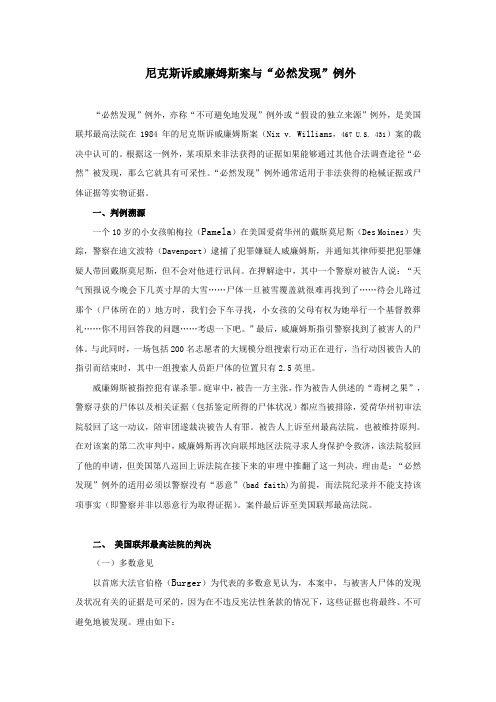
尼克斯诉威廉姆斯案与“必然发现”例外“必然发现”例外,亦称“不可避免地发现”例外或“假设的独立来源”例外,是美国联邦最高法院在1984年的尼克斯诉威廉姆斯案(Nix v. Williams,467 U.S. 431)案的裁决中认可的。
根据这一例外,某项原来非法获得的证据如果能够通过其他合法调查途径“必然”被发现,那么它就具有可采性。
“必然发现”例外通常适用于非法获得的枪械证据或尸体证据等实物证据。
一、判例溯源一个10岁的小女孩帕梅拉(Pamela)在美国爱荷华州的戴斯莫尼斯(Des Moines)失踪,警察在迪文波特(Davenport)逮捕了犯罪嫌疑人威廉姆斯,并通知其律师要把犯罪嫌疑人带回戴斯莫尼斯,但不会对他进行讯问。
在押解途中,其中一个警察对被告人说:“天气预报说今晚会下几英寸厚的大雪……尸体一旦被雪覆盖就很难再找到了……待会儿路过那个(尸体所在的)地方时,我们会下车寻找,小女孩的父母有权为她举行一个基督教葬礼……你不用回答我的问题……考虑一下吧。
”最后,威廉姆斯指引警察找到了被害人的尸体。
与此同时,一场包括200名志愿者的大规模分组搜索行动正在进行,当行动因被告人的指引而结束时,其中一组搜索人员距尸体的位置只有2.5英里。
威廉姆斯被指控犯有谋杀罪。
庭审中,被告一方主张,作为被告人供述的“毒树之果”,警察寻获的尸体以及相关证据(包括鉴定所得的尸体状况)都应当被排除,爱荷华州初审法院驳回了这一动议,陪审团遂裁决被告人有罪。
被告人上诉至州最高法院,也被维持原判。
在对该案的第二次审判中,威廉姆斯再次向联邦地区法院寻求人身保护令救济,该法院驳回了他的申请,但美国第八巡回上诉法院在接下来的审理中推翻了这一判决,理由是:“必然发现”例外的适用必须以警察没有“恶意”(bad faith)为前提,而法院纪录并不能支持该项事实(即警察并非以恶意行为取得证据)。
案件最后诉至美国联邦最高法院。
二、美国联邦最高法院的判决(一)多数意见以首席大法官伯格(Burger)为代表的多数意见认为,本案中,与被害人尸体的发现及状况有关的证据是可采的,因为在不违反宪法性条款的情况下,这些证据也将最终、不可避免地被发现。
- 1、下载文档前请自行甄别文档内容的完整性,平台不提供额外的编辑、内容补充、找答案等附加服务。
- 2、"仅部分预览"的文档,不可在线预览部分如存在完整性等问题,可反馈申请退款(可完整预览的文档不适用该条件!)。
- 3、如文档侵犯您的权益,请联系客服反馈,我们会尽快为您处理(人工客服工作时间:9:00-18:30)。
1
Cite as: 558 U. S. ____ (2009)
Per Curiam
SUPREME COURT OF THE UNITED STATES JOSEPH E. CORCORAN v. MARK LEVENHAGEN,
SUPERINTENDENT, INDIANA STATE PRISON
ON PETITION FOR WRIT OF CERTIORARI TO THE UNITED
STATES COURT OF APPEALS FOR THE SEVENTH CIRCUIT
No. 08–10495. Decided October 20, 2009
P ER C URIAM.
An Indiana jury convicted Joseph Corcoran of four counts of murder. Corcoran was sentenced to death. After Corcoran’s challenges to his sentence in the Indiana courts failed, he sought federal habeas relief. Corcoran argued in his federal habeas petition that: (1) the Indiana trial court committed various errors at the sentencing phase; (2) his sentence violated the Sixth Amendment; (3) Indiana’s capital sentencing statute was unconstitutional; (4) the prosecution committed misconduct at sentencing; and (5) he should not be executed because he suffers from a men-tal illness. See Corcoran v. Buss, 483 F. Supp. 2d 709, 719, 726 (ND Ind. 2007). The District Court granted habeas relief on Corcoran’s claim of a Sixth Amendment violation, and ordered the state courts to resentence Cor-coran to a penalty other than death. Id., at 725–726. The District Court did not address Corcoran’s other arguments relating to his sentence, noting that they were “rendered moot” by the order that Corcoran be resentenced because of the Sixth Amendment violation. Id., at 734.
The Seventh Circuit reversed the District Court’s Sixth Amendment ruling. Corcoran v. Buss, 551 F. 3d 703, 712, 714 (2008). Then, without mentioning Corcoran’s other sentencing claims, the Seventh Circuit remanded “with instructions to deny the writ,” stating that “Indiana is at liberty to reinstate the death penalty.” Id., at 714. Cor-coran sought rehearing, arguing that the Court of Appeals should have allowed the District Court to consider his
v. LEVENHAGEN
2 CORCORAN
Per Curiam
additional attacks on his sentence. But the Court of Ap-peals denied rehearing, again without referring to Cor-coran’s undecided claims.
We now grant certiorari and hold that the Seventh Circuit erred in disposing of Corcoran’s other claims with-out explanation of any sort. The Seventh Circuit should have permitted the District Court to consider Corcoran’s unresolved challenges to his death sentence on remand, or should have itself explained why such consideration was unnecessary.
In its brief in opposition, the State argues that Cor-coran’s claims were waived, and that they were in any event frivolous, so that a remand would be wasteful. Brief in Opposition 9–10. Nothing in the Seventh Circuit’s opinion, however, suggests that this was the basis for that court’s order that the writ be denied.
The petition for certiorari and the motion for leave to proceed in forma pauperis are granted. The judgment of the Court of Appeals for the Seventh Circuit is vacated, and the case is remanded for further proceedings consis-tent with this opinion.
It is so ordered.。
